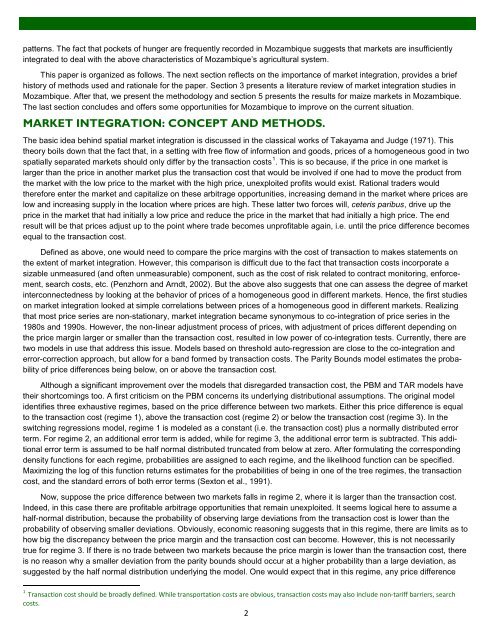Market Integration in Mozambique - International Food Policy ...
Market Integration in Mozambique - International Food Policy ...
Market Integration in Mozambique - International Food Policy ...
You also want an ePaper? Increase the reach of your titles
YUMPU automatically turns print PDFs into web optimized ePapers that Google loves.
patterns. The fact that pockets of hunger are frequently recorded <strong>in</strong> <strong>Mozambique</strong> suggests that markets are <strong>in</strong>sufficiently<br />
<strong>in</strong>tegrated to deal with the above characteristics of <strong>Mozambique</strong>’s agricultural system.<br />
This paper is organized as follows. The next section reflects on the importance of market <strong>in</strong>tegration, provides a brief<br />
history of methods used and rationale for the paper. Section 3 presents a literature review of market <strong>in</strong>tegration SUMMARY studies | APRIL 2010 <strong>in</strong><br />
<strong>Mozambique</strong>. After that, we present the methodology and section 5 presents the results for maize markets <strong>in</strong> <strong>Mozambique</strong>.<br />
The last section concludes and offers some opportunities for <strong>Mozambique</strong> to improve on the current situation.<br />
MARKET INTEGRATION: CONCEPT AND METHODS.<br />
The basic idea beh<strong>in</strong>d spatial market <strong>in</strong>tegration is discussed <strong>in</strong> the classical works of Takayama and Judge (1971). This<br />
theory boils down that the fact that, <strong>in</strong> a sett<strong>in</strong>g with free flow of <strong>in</strong>formation and goods, prices of a homogeneous good <strong>in</strong> two<br />
spatially separated markets should only differ by the transaction costs 1 . This is so because, if the price <strong>in</strong> one market is<br />
larger than the price <strong>in</strong> another market plus the transaction cost that would be <strong>in</strong>volved if one had to move the product from<br />
the market with the low price to the market with the high price, unexploited profits would exist. Rational traders would<br />
therefore enter the market and capitalize on these arbitrage opportunities, <strong>in</strong>creas<strong>in</strong>g demand <strong>in</strong> the market where prices are<br />
low and <strong>in</strong>creas<strong>in</strong>g supply <strong>in</strong> the location where prices are high. These latter two forces will, ceteris paribus, drive up the<br />
price <strong>in</strong> the market that had <strong>in</strong>itially a low price and reduce the price <strong>in</strong> the market that had <strong>in</strong>itially a high price. The end<br />
result will be that prices adjust up to the po<strong>in</strong>t where trade becomes unprofitable aga<strong>in</strong>, i.e. until the price difference becomes<br />
equal to the transaction cost.<br />
Def<strong>in</strong>ed as above, one would need to compare the price marg<strong>in</strong>s with the cost of transaction to makes statements on<br />
the extent of market <strong>in</strong>tegration. However, this comparison is difficult due to the fact that transaction costs <strong>in</strong>corporate a<br />
sizable unmeasured (and often unmeasurable) component, such as the cost of risk related to contract monitor<strong>in</strong>g, enforcement,<br />
search costs, etc. (Penzhorn and Arndt, 2002). But the above also suggests that one can assess the degree of market<br />
<strong>in</strong>terconnectedness by look<strong>in</strong>g at the behavior of prices of a homogeneous good <strong>in</strong> different markets. Hence, the first studies<br />
on market <strong>in</strong>tegration looked at simple correlations between prices of a homogeneous good <strong>in</strong> different markets. Realiz<strong>in</strong>g<br />
that most price series are non-stationary, market <strong>in</strong>tegration became synonymous to co-<strong>in</strong>tegration of price series <strong>in</strong> the<br />
1980s and 1990s. However, the non-l<strong>in</strong>ear adjustment process of prices, with adjustment of prices different depend<strong>in</strong>g on<br />
the price marg<strong>in</strong> larger or smaller than the transaction cost, resulted <strong>in</strong> low power of co-<strong>in</strong>tegration tests. Currently, there are<br />
two models <strong>in</strong> use that address this issue. Models based on threshold auto-regression are close to the co-<strong>in</strong>tegration and<br />
error-correction approach, but allow for a band formed by transaction costs. The Parity Bounds model estimates the probability<br />
of price differences be<strong>in</strong>g below, on or above the transaction cost.<br />
Although a significant improvement over the models that disregarded transaction cost, the PBM and TAR models have<br />
their shortcom<strong>in</strong>gs too. A first criticism on the PBM concerns its underly<strong>in</strong>g distributional assumptions. The orig<strong>in</strong>al model<br />
identifies three exhaustive regimes, based on the price difference between two markets. Either this price difference is equal<br />
to the transaction cost (regime 1), above the transaction cost (regime 2) or below the transaction cost (regime 3). In the<br />
switch<strong>in</strong>g regressions model, regime 1 is modeled as a constant (i.e. the transaction cost) plus a normally distributed error<br />
term. For regime 2, an additional error term is added, while for regime 3, the additional error term is subtracted. This additional<br />
error term is assumed to be half normal distributed truncated from below at zero. After formulat<strong>in</strong>g the correspond<strong>in</strong>g<br />
density functions for each regime, probabilities are assigned to each regime, and the likelihood function can be specified.<br />
Maximiz<strong>in</strong>g the log of this function returns estimates for the probabilities of be<strong>in</strong>g <strong>in</strong> one of the tree regimes, the transaction<br />
cost, and the standard errors of both error terms (Sexton et al., 1991).<br />
Now, suppose the price difference between two markets falls <strong>in</strong> regime 2, where it is larger than the transaction cost.<br />
Indeed, <strong>in</strong> this case there are profitable arbitrage opportunities that rema<strong>in</strong> unexploited. It seems logical here to assume a<br />
half-normal distribution, because the probability of observ<strong>in</strong>g large deviations from the transaction cost is lower than the<br />
probability of observ<strong>in</strong>g smaller deviations. Obviously, economic reason<strong>in</strong>g suggests that <strong>in</strong> this regime, there are limits as to<br />
how big the discrepancy between the price marg<strong>in</strong> and the transaction cost can become. However, this is not necessarily<br />
true for regime 3. If there is no trade between two markets because the price marg<strong>in</strong> is lower than the transaction cost, there<br />
is no reason why a smaller deviation from the parity bounds should occur at a higher probability than a large deviation, as<br />
suggested by the half normal distribution underly<strong>in</strong>g the model. One would expect that <strong>in</strong> this regime, any price difference<br />
1 Transaction cost should be broadly def<strong>in</strong>ed. While transportation costs are obvious, transaction costs may also <strong>in</strong>clude non-tariff barriers, search<br />
costs.<br />
2
















